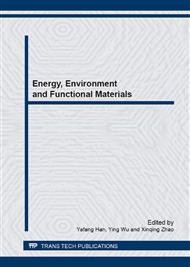p.373
p.378
p.383
p.387
p.395
p.401
p.407
p.412
p.419
Synthesis and Characterization of Surfactant-Free PDEA/PMAA of IPN Nanogel
Abstract:
Based on the hydrogen bonding between MAA and PDEA, the synthesis of surfactant-free PDEA/PMAA interpenetrating (IPN) nanogels was studied in ultrapure water with N, N-methylene acrylamide (BIS) as a crosslinker, ammonium peroxodisulfate (APS) as an initiator, N,N,N',N'-Tetramethylethylenediamine (TEMED) as an accelerator. First, poly (N, N-diethyl acrylamide) (PDEA) nanogels were synthesized using emulsion precipitation polymerization. As MAA was polymerized in the aqueous dispersion of PDEA nanogels as seeds, PDEA nanogels got interpenetrated with poly (methacrylic acid) (PMAA) due to the effect of the hydrogen bonding between PDEA and PMAA. The chemical structure of the PDEA/PMAA nanogels was studied with Fourier transform infrared (FTIR) spectroscopy. The nanogels morphology was characterized with transmission electron microscopy (TEM) and atomic force microscopy (AFM). And the volume phase transition behaviors and swelling properties were studied with dynamic light scattering (DLS). The experimental results show that the interpenetrating nanogels were very sensitive to temperature. As the amount of MAA increased, the volume of the neutralized PDEA/PMAA nanogels changed less above phase transition temperature and was finally no change. The temperature responsive PDEA/PMAA nanogels will promise to have significant influence on fundamental studies and real applications.
Info:
Periodical:
Pages:
395-400
Citation:
Online since:
April 2014
Authors:
Keywords:
Price:
Сopyright:
© 2014 Trans Tech Publications Ltd. All Rights Reserved
Share:
Citation:


